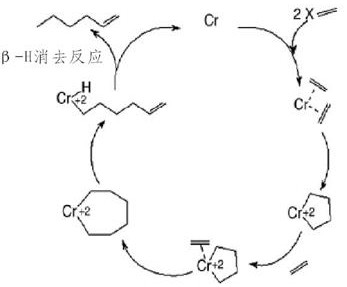Chromite catalyst for trimerization of ethylene into 1-hexene and preparation and application thereof
A technology of chromium catalyst and hexene, applied in the field of chromous catalyst and its preparation and application, to achieve the effect of reducing operating costs
- Summary
- Abstract
- Description
- Claims
- Application Information
AI Technical Summary
Problems solved by technology
Method used
Image
Examples
Embodiment 1
[0040] 1. Preparation of chromous isooctanoate
[0041] Under anhydrous and oxygen-free conditions, chromocene is used as raw material to react with isooctanoic acid to generate chromous isooctanoate, which is heated to remove cyclopentadiene for use.
[0042] 2. Preparation of catalyst
[0043] in the N 2 Add 10 mL of dehydrated toluene, chromous isooctanoate (0.03 mmol) synthesized in Step 1, 2,5-dimethylpyrrole (29 mg), and triethylaluminum (10 mL) into a fully replaced stirred 100 mL reactor , 1,1,2,2-tetrachloroethane (7mL, 0.54mmol), react at room temperature for 10min and set aside.
[0044] 3. Trimerization of ethylene
[0045] A 500mL autoclave was heated to vacuum for 2 hours, replaced with nitrogen several times, filled with ethylene, cooled to a predetermined temperature, and dehydrated cyclohexane (200mL) and the above-mentioned catalyst were added. The oligomerization reaction was carried out at 90°C and a pressure of 5.0 MPa. After 40 minutes of reaction, th...
Embodiment 2
[0047] 1. Preparation of chromous isooctanoate
[0048] Under anhydrous and oxygen-free conditions, chromous diacetate reacts with hydrochloric acid to generate chromous chloride, and chromous chloride, sodium hydroxide, and isooctanoic acid undergo metathesis reactions to generate chromous isooctanoate.
[0049] 2. Preparation of catalyst
[0050] in the N 2 Add dehydrated toluene (10mL), chromous isooctanoate synthesized in step 1, 2,5-dimethylpyrrole (29mg), triethylaluminum (10mL) into a fully replaced stirred 100mL reactor, 1 , 1,2,2 Tetrachloroethane (0.069mmol) was reacted at room temperature for 5 minutes before use.
[0051] 3. Trimerization of ethylene
[0052] A 500mL autoclave was heated to vacuum for 2 hours, replaced with nitrogen several times, filled with ethylene, cooled to a predetermined temperature, and dehydrated cyclohexane (200mL) and the above-mentioned catalyst were added. The oligomerization reaction was carried out at 20°C and a pressure of 5.0 M...
Embodiment 3
[0054] 1. Preparation of chromous isooctanoate
[0055] Under nitrogen protection conditions, solid metal chromium reacts with 20% hydrochloric acid at a temperature of 50-80°C to synthesize chromous chloride, which undergoes metathesis reaction with sodium hydroxide and isooctanoic acid to generate isooctanoic acid Chromous.
[0056] 2. Preparation of catalyst
[0057] in the N 2 Add dehydrated toluene (10mL), chromous isooctanoate synthesized in step 1, triethylaluminum (10mL), 1,1,2,2 tetrachloroethane (0.069 mmol) were reacted at room temperature for 5 minutes for later use.
[0058] 3. Trimerization of ethylene
[0059] A 500mL autoclave was heated to vacuum for 2 hours, replaced with nitrogen several times, filled with ethylene, cooled to a predetermined temperature, and dehydrated cyclohexane (200mL) and the above-mentioned catalyst were added. The oligomerization reaction was carried out at 20°C and a pressure of 5.0 MPa. After 20 minutes of reaction, the temperat...
PUM
 Login to View More
Login to View More Abstract
Description
Claims
Application Information
 Login to View More
Login to View More - Generate Ideas
- Intellectual Property
- Life Sciences
- Materials
- Tech Scout
- Unparalleled Data Quality
- Higher Quality Content
- 60% Fewer Hallucinations
Browse by: Latest US Patents, China's latest patents, Technical Efficacy Thesaurus, Application Domain, Technology Topic, Popular Technical Reports.
© 2025 PatSnap. All rights reserved.Legal|Privacy policy|Modern Slavery Act Transparency Statement|Sitemap|About US| Contact US: help@patsnap.com


